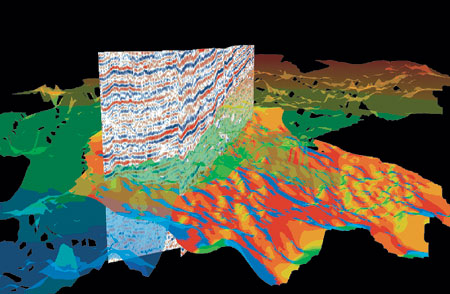Technology at Work: Data storage system raises productivity
TECHNOLOGY AT WORKData storage system raises productivity
Nuevo produces about 54,000 boe per day. Despite a market capitalization of roughly $300 million, it has only about 100 employees. The company outsources certain accounting, financial, human resources and direct field-operation functions. Geological and geophysical software applications are another area in which the company makes extensive use of outsourcing. Although the company has its own G&G employees, software maintenance and support are contracted through Landmark Graphics Corp., giving Nuevo access to many popular seismic-interpretation and geologic-modeling packages. Analyzing well and seismic data. Nuevo has one office in Texas and two in California. "In our California offices, the focus is on well data," Zimmerman said. "For instance, when we have hundreds of wells in a mature field, the objective is to optimize production. With so many closely spaced wells, the issue is handling large amounts of information in a short timeframe. The primary task is loading and interpreting new well data so we can update our maps and build new cross-sections to guide future efforts." Conversely, geoscientists in Houston work primarily on large-scale international projects that carry both high risks and high potential rewards. "Some of these projects have less than a dozen wells covering a million-acre permit. In this context, seismic data plays a larger role, so data accessibility and reliability are required," said Zimmerman. Given the varied nature and locations of assets, as well as their effect on data requirements, Nuevo concluded that response time and reliability provided to its technical staff was essential to its business. Only by performing the scientific IT function in-house could the company prevent bottlenecks in the exploration process. Selecting the data server. Sun Ultra 60 workstations with 500 MB to 2 GB of memory were chosen as the principal hardware platform for desktops. Seismic data provides special data storage and access challenges. Most of the seismic data used by Nuevo’s Houston office ranges from 20 to 30 GB. Geophysicists frequently have to work with multiple data sets, so they read and reread data off the discs on a regular basis – and they need to do so quickly. Because people often work in teams analyzing data, they need to have access to large, varied data sets in one location (see figure). "These factors mean that local storage can only be a small part of the solution," Zimmerman said, "We first looked at one of the high-end enterprise storage-system providers. Their solution was well regarded for dependability as a server for business applications, but they had little experience with handling seismic data, and their solution came at a higher cost than our budget allowed. We also examined server-attached storage systems that simply hang RAID from a workstation. We selected the NS2000 because of the strong track record that this machine has achieved in delivering high performance and reliability to the oil and gas industry at a reasonable cost." The key to the high I/O performance of the server system is its dedicated processor architecture that is optimized for the purpose of moving file data as efficiently as possible from disk to network and vice versa. The I/O node is the fundamental building block of the machine’s architecture. Each node contains a dual-Intel processor motherboard that has different and logically separate processing functions. The network processor handles network protocols and manages associated caches. The file and storage processor is dedicated to managing the file systems and associated storage hardware. The result is a dramatic improvement in performance.
Access for Unix and Windows users. Another advantage of the new server is that it can serve both Unix and Windows NT machines. "This feature eliminates the need to provide a separate Windows NT-based storage system for the production accounting applications used by our engineers," Zimmerman said. "It will become even more important in the future as we begin to migrate some of our geophysical applications to the NT world." The data server consolidates UNIX and Windows NT on the same platform using NeTservices, which is NS2000 compatible. NeTservices concurrently delivers native file services to thousands of UNIX and Windows clients, while being fully integrated into both environments from a user access and administrative standpoint. It is fully compatible with Microsoft’s Common Internet File System file-sharing protocol and NT Server 4.0 directory, data security and remote administration services, so no additional software is required on any Windows clients. "Performance of the new data servers has been
outstanding," Zimmerman concluded. "Our high-end users work simultaneously on the system and we have
had few complaints about slow performance. Even more important, since the systems were installed in 1998, we
have had no downtime attributable to new system. The combination of faster performance and zero downtime has
significantly increased productivity of our users, although it’s impossible to measure by how much. In my
opinion, this device provides an ideal platform for high-performance data storage for geological and
geophysical data analysis."
|



